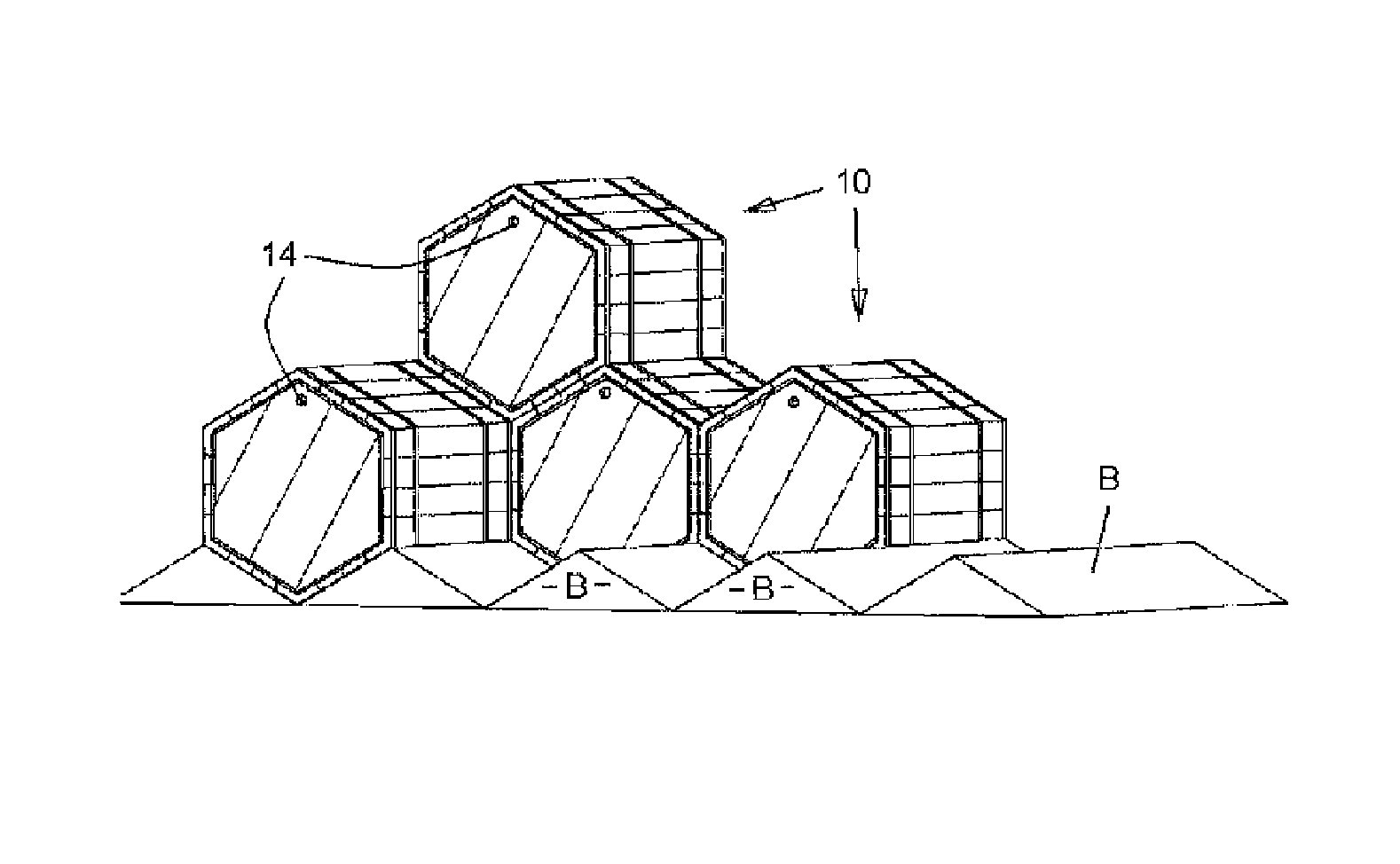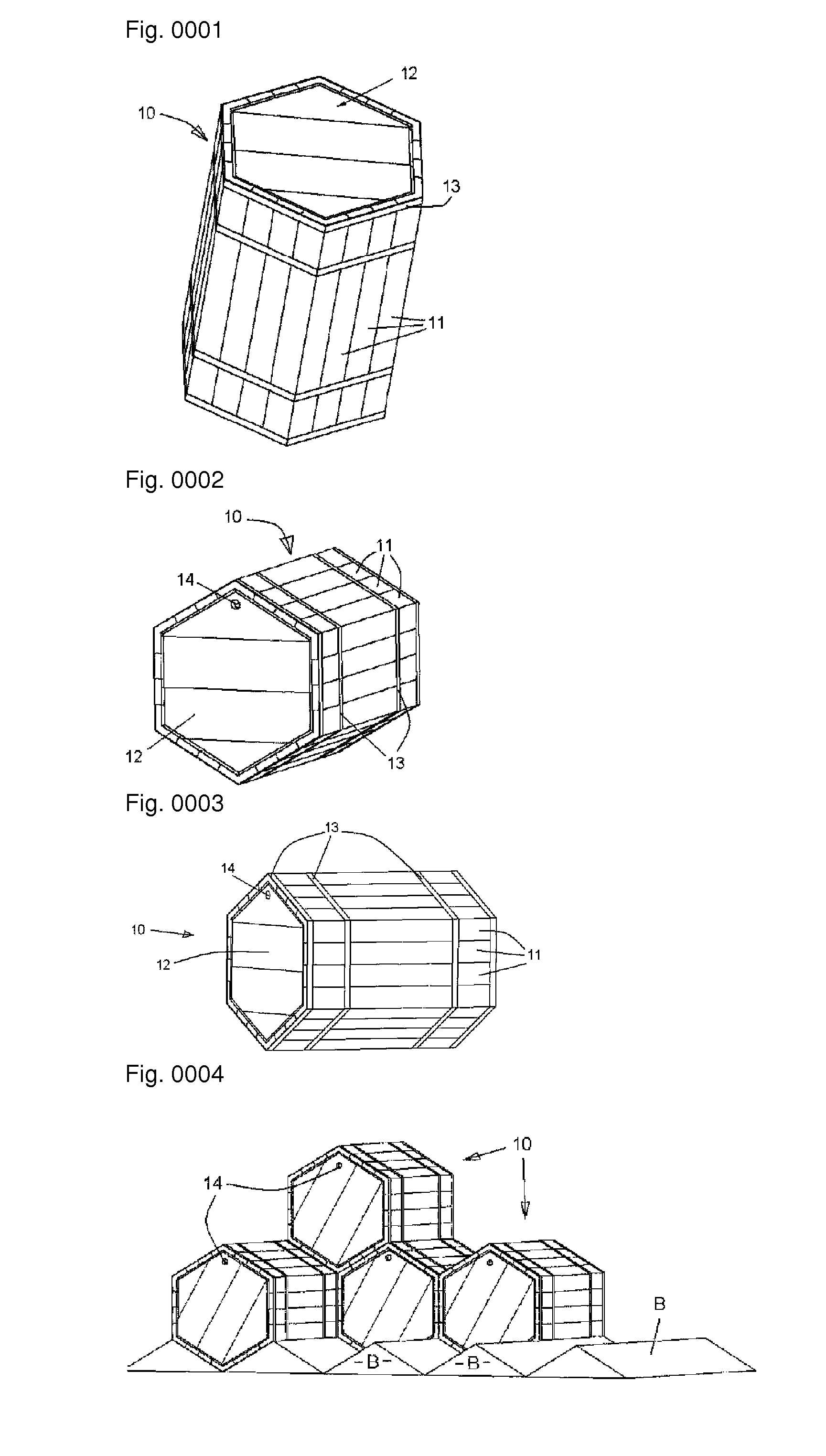Cask
a technology of casks and spherical plates, applied in the field of casks, can solve the problems of over-all bulge when it is assembled and bound together, and achieve the effect of reducing the overall bulg
- Summary
- Abstract
- Description
- Claims
- Application Information
AI Technical Summary
Benefits of technology
Problems solved by technology
Method used
Image
Examples
first embodiment
[0032]FIGS. 1 to 3 show general views of a whisky cask according to the invention. A cask 10 is assembled from a plurality of staves 11 arranged around a hexagonal end 12 which itself is formed from several lengths of oak. The staves are bound together by several straps 13 that are tensioned and joined in a conventional manner. Ideally a strap 13 is placed at each end of the cask to compress the staves against the hexagonal ends 12 such that they are sealed therewith.
[0033]Stave edges may be constructed with tongue-in-groove joints to assist assembly. This is distinguished from other construction methods that require adhesives or other mechanical fasteners (e.g. bolts or screws) that may affect the taste of the stored spirit. An alternative to a tongue-in-groove joint is a convex radius mating with a matching concave radius, however, any suitable joining method could be employed.
[0034]FIGS. 2 and 3 each show an access / bung hole 14 located at a corner of the hexagonal cask shape. It ...
second embodiment
[0043]FIGS. 7 and 8 illustrate a second embodiment that is analogous to the cask of FIGS. 1 to 6. In this embodiment the cask 17 has a triangular prism configuration such that it can be stacked, once again, to provide a distribution of forces that tightly packs the units together thereby minimising spirit loss. The cask 17 also has a bung 14 located at an uppermost portion (top corner or 12 o'clock position) where it can result in even less empty space in the cask than a hexagonal configuration, if filled to below the hole.
[0044]FIG. 8 shows that the generally equilateral triangle ended casks fit together in an alternating flat and upturned position to form a stack. In this case the bungs 14 should be formed at two different positions, i.e. at a corner and top edge, depending on what orientation the cask takes. Such holes can be drilled after stacking prior to filling.
[0045]As in the case of stacking hexagonal casks, the triangular shape will naturally lead to a pyramid type constru...
third embodiment
[0049]It will be clear from the foregoing that the invention is embodied by a method of stacking straight-walled casks, to utilise the natural compression between units that will minimise spirit loss when packed in a warehouse for an extended time period. In this regard, a third embodiment, illustrated by FIG. 10, utilises a square-ended cask 19 that is stacked to result in a diamond nestled configuration, taking advantage of similarly natural compression of the staves in the cask as other embodiments.
[0050]Square / diamond-ended casks as stacked according to the method of the invention, require a base B comparable to FIG. 4, which will support the downwardly pointed (6 o'clock) corner of the cask 19. It is also possible, as with hexagonal and triangular configurations, to use a side supporting structure to enable more space efficient stacking in a vertical direction, rather than the self supporting n−1 successive row configuration as shown in FIG. 10.
[0051]Square / diamond casks 19 can...
PUM
 Login to View More
Login to View More Abstract
Description
Claims
Application Information
 Login to View More
Login to View More - R&D
- Intellectual Property
- Life Sciences
- Materials
- Tech Scout
- Unparalleled Data Quality
- Higher Quality Content
- 60% Fewer Hallucinations
Browse by: Latest US Patents, China's latest patents, Technical Efficacy Thesaurus, Application Domain, Technology Topic, Popular Technical Reports.
© 2025 PatSnap. All rights reserved.Legal|Privacy policy|Modern Slavery Act Transparency Statement|Sitemap|About US| Contact US: help@patsnap.com



